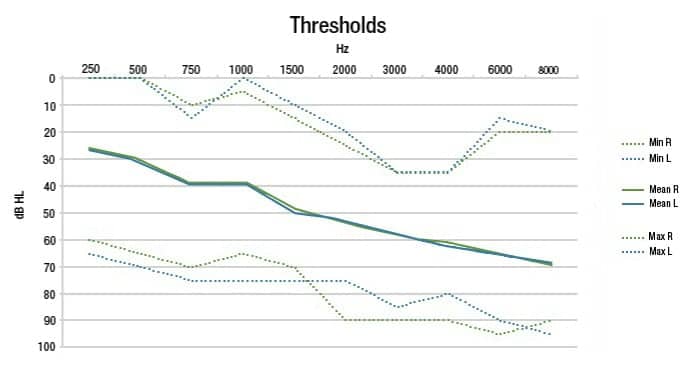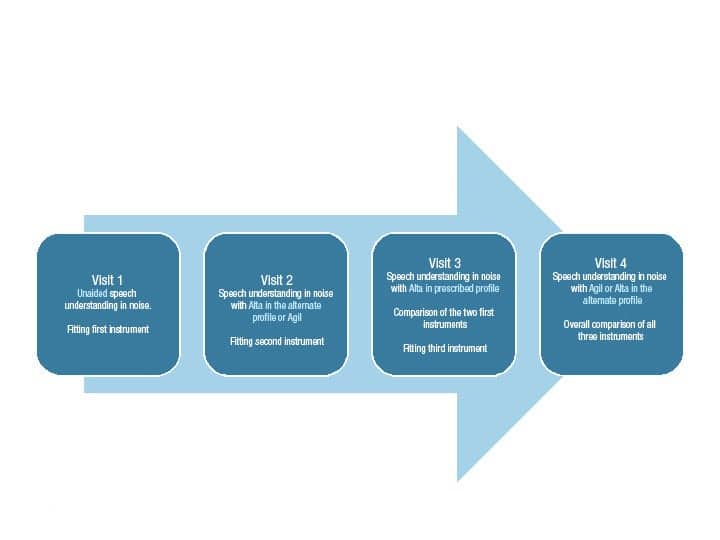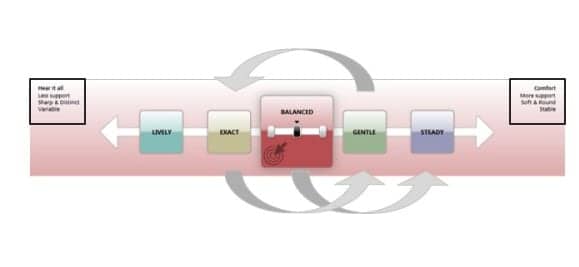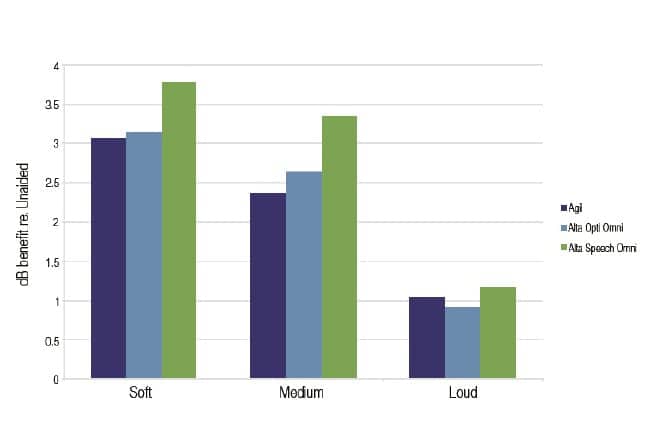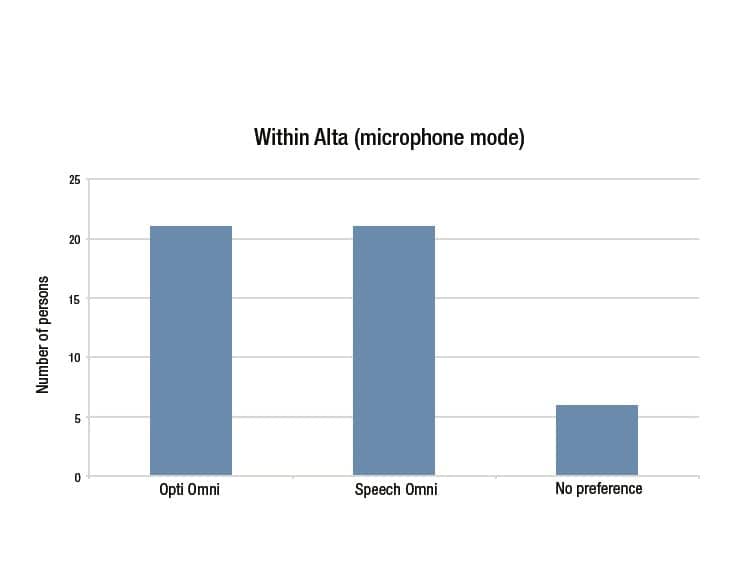By Julie Neel Weile, MA; Lia Santiago, AuD; Craig W. Newman, PhD; and Sharon A. Sandridge, PhD
This paper describes the findings from a large-scale clinical trial evaluating the performance of the new Oticon Alta hearing instrument. Results confirm that the Alta outperforms the previous-generation Oticon Agil hearing instrument. Results also demonstrate that satisfaction increases when the devices can be adjusted to the needs and preferences of the user.
Within the areas of performance and personalization, three questions were outlined:
- How does Alta perform in comparison to Agil in different personal profiles?
- How is preference distributed across instruments and personal profiles?
- Is the overall preference predictable based solely on laboratory measures of speech in noise performance?
The Clinical Study
Method. The study was performed at two test sites: the Audiology Clinic at the Head & Neck Institute at Cleveland Clinic in Cleveland, Ohio, and Hörzentrum, Oldenburg, Germany.
A total of 50 hearing-impaired participants were recruited, 25 at each site. Participants were experienced hearing instrument users with mild to moderately severe symmetrical sensorineural hearing loss of predominantly flat or gently sloping configuration (Figure 1). One participant at each site discontinued participation during the course of the test period. Thus, a total of 48 participants completed the study.
The study employed a cross-over design in which participants wore each hearing instrument for a 2-week period in their typical listening environments prior to lab testing (Figure 2). During the first visit, baseline unaided speech perception measures were obtained. This baseline was used as a reference for measuring the benefit of wearing the different hearing instruments. Following testing, the first set of hearing instruments was fit and the participant used the devices for 10-14 days. At each subsequent visit, completed after the 10- to 14-day use period, the participants were tested while wearing the just-worn settings/devices. A new set of instruments were fit and worn for another 10- to 14-day period. The instrument or fitting algorithm was evaluated in a semi-random order.
The test instruments included the Oticon Agil and Oticon Alta. Alta was tested using two different personal profiles: a profile prescribed for the user based on age, hearing loss, and listening preferences, and an alternative profile. Participants were seen four times for lab testing and had three wear periods over the course of 6 to 8 weeks. The order of the trial was counterbalanced, with a trial involving Agil always following or preceding the trial with the prescribed personal profile. Two trial orders were possible: 1) Agil, Alta in prescribed, and Alta in alternate, and 2) Alta in alternate, Alta in prescribed, and Agil.
Hearing instruments. All participants were fitted with Oticon Agil and Oticon Alta devices in RITE style instruments coupled with an “85” receiver. Most individuals used a custom micro mold; however, some patients used domes. Reasons included comfort of fit and ear canal too narrow to accommodate speaker and micro mold.
For Oticon Agil, the prescribed identity based on hearing loss, experience, and auditory lifestyle was used. With Oticon Alta, the new personal profiles were used. These profiles take the instrument wearer’s auditory lifestyle, abilities, sound preference, as well as background information into account. Participants were blinded to which instrument they wore during each test or trial. Even though the two instruments were identical in color and casing, they differed slightly in the look and feel of the push button and look of the speaker unit, so differences were noticeable if the subject analyzed the devices carefully.
“Inside” the instruments there are a number of differences between Agil and Alta. Alta, built on the Inium chip, has an extended near-linear window in Speech Guard and a new anti-feedback system in Inium feedback shield. Additionally, Spatial Sound has been optimized in Spatial Sound Premium.
The concept of Free Focus was introduced with Alta as part of the extended possibilities within personalization. Based on the personal profile, the hearing instrument can be fitted with different surround modes: the transparent omni mode with light frontal focus (Optimized Omni), or a more directional omni mode (Speech Omni). This choice is based on the listening needs and preferences of the user.
Personal Profiles in Alta. In the study, all participants used two different personal profiles in Oticon Alta: one that was prescribed based on age, hearing loss, and the participant’s answers to the questions in the Preference Manager (part of YouMatic), and an alternate to that prescribed personal profile, which was “two personal profiles away” (see Figure 3). The reason for moving two profiles, and not just one, was to ensure that the switch would entail a change in surround microphone mode (from Opti Omni to Speech Omni or the other way around). In addition to change in surround microphone mode, the switch between profiles also affects the sensitivity of all the help systems.
For example, a participant meeting the criteria for the Exact personal profile had a field trial with these settings and then a period in a Gentle personal profile (the alternative profile). The opposite scenario also existed: fit with the alternative followed by the prescribed profile.
The two Alta settings were always tested one after the other to allow a direct comparison between the profiles. The change of personal profile toward either end of the personal profile continuum represents a change in the settings of the automatics—either toward providing more support from the help systems and, thus, more comfort (in the direction of Gentle and Steady), or a change to a more transparent setting where less help is provided by help systems (in the direction of Balanced or Exact).
For the results, the participants are grouped by the personal profile’s surround microphone mode: Optimized Omni in Exact and Balanced profiles, and Speech Omni in Gentle and Steady profiles.
Laboratory tests. Speech understanding in noise was evaluated using the Hearing in Noise Test (HINT) in language versions appropriate for the subjects. In this test paradigm, a sentence is played to the person in the presence of background noise. The participant is instructed to repeat what he or she heard. The level of the sentences is varied relative to the noise so the person is able to repeat 50% of the sentences correctly. In this study, the HINT was performed using three noise levels: a soft level with noise at 55 dB SPL, a medium level with noise at 65 dB SPL, and a loud level with noise at 75 dB SPL.
The speaker setup for the HINT differed for each of the three levels. That is, testing at the soft level involved speakers positioned to mimic a conversation with a person in front while someone else was talking from behind (maskers at 180° and 315° azimuth playing multi-talker babble). At the medium level, the target was still coming from the front of the person while the person was surrounded by noise (maskers at 45°, 135°, 225°, and 315° playing unmodulated noise). The instruments were in the omnidirectional setting in these two listening environments. Speaker configuration for the loud level was identical to the medium level; however, multi-talker babble was presented instead of unmodulated noise. In this case, the instruments were set in the split directional mode as this would typically be the one chosen by the automatic system in a sound environment like this.
Results from the tests of speech understanding in the laboratory were analyzed using repeated measures ANOVA with site as between subject effect and instrument (Agil and the two Alta profiles) and condition (soft, medium, and loud presentation level) as within subject effects. All interactions were explored using Post-Hoc Tukey analyses.
Preference. After the two first trials, the participants were asked which instrument they preferred. This was repeated after all three trials. After the final trial period, the participant was asked which of the three instruments was preferred. The setup of the trial was arranged so the comparisons were between Agil and Alta in a prescribed personal profile and between Alta in a prescribed profile and Alta in an alternate profile. The final overall preference was made after all devices had been worn.
Performance in the Laboratory
Analysis showed that there was no statistically significant difference between sites, which allowed a pooling of the data. Accordingly, all the following analyses have the data combined across sites.
To calculate the benefit from the different instruments and profiles, the performance measured with the instrument was compared to the performance measured without instruments, which was obtained at the first visit. This calculation was done for each participant and then averaged. These results are shown in Figure 4. Benefit is expressed in dB relative to unaided scores. This dB value can be interpreted as the increase in speech understanding with 1 dB corresponding to approximately 10% increase in intelligibility (cf, the psychometric function of the test).
| Figure 4. Improvement in performance gained from aiding across the three test levels; Soft (55 dB), Medium (65 dB), and Loud (75 dB). (Click to enlarge.) |
In all conditions, the use of hearing instruments resulted in an improvement of speech understanding in noise. For example, in the soft condition, the mean score was 3.79 dB better with an Alta instrument in Speech Omni than without an instrument. This translates to a 38% performance benefit over unaided.
As anticipated, the benefit the participants gained from being aided was greater for the soft level than for the loud level. This is comparable to findings from Studebaker et al,1 which showed that both normal-hearing and hearing-impaired individuals experienced a decrease in speech intelligibility in noise as levels increased over conversational levels.
Steady and Gentle personal profiles in Alta feature Speech Omni, which is a slightly more directional default microphone mode than Optimized Omni. These modes also activate more help systems, even in less complicated environments. This combination, and especially the contribution from the Speech Omni microphone mode, may have been the main contribution to the improvement relative to the other Alta personal profiles.
For the medium condition, participants scored significantly higher with Alta in a personal profile with Speech Omni than with Agil (p=0.0035) and Alta in a personal profile with Optimized Omni (p=0.045). This confirms the effect of increased help from the more directional microphone and increased level of help system activity.
However, performance in the laboratory does not predict perceived hearing aid benefit or patient satisfaction with hearing instruments. Subjective listening preference and satisfaction in real life situations bear great weight in the user’s feeling of success with wearing amplification.
Preference in the Field
Overall hearing instrument preference (Figure 5) was positively skewed towards Alta (prescribed or alternative profile) versus Agil.
Figure 6 compares preference between the two trialed Alta personal profiles. Profiles are adjusted and named after their default surround mode.
The prescribed Alta profile was based on the completion of the four questions in the Preference Manager in the Genie fitting software prior to the test start. Due to time constraints and the more objective nature of the study, a more individualized based process with use of sound demos and dialog between hearing instrument user and hearing care professional was not possible or within the scope of the study. Conversations between the user and the professional could correct potential erroneous perceptions of questions, just as the explanatory follow-up questions from the hearing aid instructional materials could have led to greater understanding of where each question would lead the user. In the efforts to find the most preferable setting for the hearing instrument user from the beginning, the hearing care professional plays a significant role in making the possibilities that exist in the instrument easy to understand and accessible to the user.
Valuable insights were gained from the participants’ comparison of the two different profiles within Alta. The majority of participants were able to determine their preference between Alta with prescribed settings and Alta with alternative settings (or Opti Omni vs Speech Omni). When choosing head-to-head between the two Alta profiles, 21 chose an Optimized Omni based personal profile, 21 chose a Speech Omni based personal profile, and 6 did not prefer one over the other.
The relationship between preferred instrument and improved performance in the HINT is not clear. Table 1 illustrates the relationship between the performance in the speech in noise test (medium level) and the preference between the two trialed personal profiles, categorized by surround microphone mode. The percentages refer to the share of higher performers within each preference group.
When grouping the participants by preferred personal profile as named after surround microphone mode and by the personal profile that led to better performance on the speech in noise test, the distribution is shown in Table 1. Excluded from this table are 10 participants; 6 did not have a preference for either profile over the other and 4 performed equally well on the speech in noise test. The table shows that 73.7% (28 out of 38) performed better with Oticon Alta in Speech Omni. However, 20 of 38 (52.6%) preferred a personal profile with the Opti Omni setting.
Based on these results, performance in a laboratory test cannot stand alone as sole predictor for preference. The listening experiences in everyday situations play an important role in how an instrument is perceived. Overall optimized sound quality would therefore not be possible without the different profiles available, which justifies the importance placed on individualization obtainable with personal profiles in Alta.
Interestingly, based on only two trial periods of 10-14 days each, the participants were able to make a preference judgment between the Alta profiles. After three trials, they continued to express preferences. This supports the philosophy that it can be valuable for the clients to have the opportunity to go through a personalization process and have options that impact the automatic settings of the devices.
Comments from the German test site indicated that the perceived benefits from either setting were quite heterogeneous; improved speech intelligibility was expressed by some when moving from the Opti Omni to Speech Omni, while others found it to be the other way around. The same tendencies were seen with regard to sound quality. This could support the idea of some preferring—and perhaps, needing—more support from the help systems to do segregation of speech and noise while others prefer less support.
In-depth analysis of client background data, answers to questions in the preference manager, and overall preference judgments will be performed as part of the larger-scale publication in preparation in cooperation with the researchers from Cleveland Clinic.
Conclusion
The study on performance and personalization performed at two sites (Germany and the United States) confirms the hypothesis that hearing-impaired users perform better on speech intelligibility testing with Alta than with Agil.
Results also suggest that Oticon Alta in personal profiles with Speech Omni mode performed significantly better than Agil. This extra help from a more directional mode also led to significantly better speech understanding in noise with Alta in Speech Omni mode than Alta in Opti Omni. However, when asked which instrument or mode the participants preferred, the distribution between the two was 50/50—even though performance in many instances would indicate otherwise. Performance was not the sole indicator for preference.
Furthermore, it indicates that hearing aid users can play an important role in choosing the preferred hearing aid settings. The current study demonstrates this based on at-home trials, but tools to make the choice in the clinic are available to help maximize satisfaction.

|

|

|

|
| Julie Neel Weile, MA, is a Clinical Research Audiologist in the Clinical Evidence & Communication department of Oticon A/S, in Smoerum, Denmark. Lia Santiago, AuD, is a Research Fellow in the Head & Neck Institute, Craig W. Newman, PhD, is the Section Head of Audiology and Co-Director of the Audiology Research Laboratory in the Head & Neck Institute, and Sharon A. Sandridge, PhD, is the Director of Clinical Audiology Services and Co-Director of the Audiology Research Laboratory in the Head & Neck Institute at the Cleveland Clinic. | |||
Reference
1. Studebaker GA, Sherbecoe RL, McDaniel DM, Cwaltney CA. Monosyllabic word recognition at higher-than-normal speech and noise levels. J Acoust Soc Am. 1999;105(4):2431-2444.


